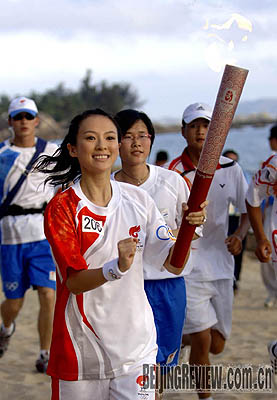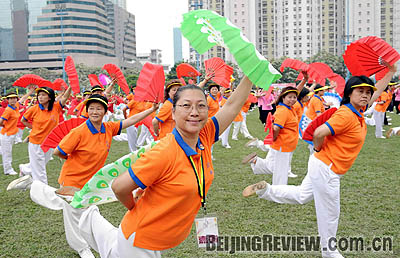|

BEAUTY AND THE BEACON: Film star Zhang Ziyi carries the Olympic torch in Hainan on May 4 Photo by ZHAO YINGQUAN
The Olympic flame landed in Hong Kong on April 30, with 100 days to go before the opening of the Games. It was the first stop on Chinese soil for the symbol of "peace, friendship, hope," after a tumultuous trip around the world, crossing five continents and 19 cities.
The theme song for the torch relays of the 2008 Olympics and Paralympics--Light the Passion, Share the Dream--was released the same day.
Both events marked a final push toward the Beijing Olympics, which China has been waiting for with bated breath.
Ready to begin
On the morning of April 30, Wei Qiang, who works in Beijing Environmental Protection Monitoring Center, was replacing the dust-proof membrane of the automatic air quality monitoring station in the Olympic Forest Park.
"As an environmental protection worker, it is my responsibility to prove the improvement of the air quality in Beijing by monitoring data," said Wei. The data showed that up to April 29 this year there were 86 good air quality days, while the total number for 1998 was just 100. "The number of days with blue sky in the first season of this year is the most in the past nine years," said Wei.
Since August of last year, Beijing and other co-host cities have held more than 40 "Good Luck Beijing" test competitions in order to uncover every possible problem.
Beijing has also improved food safety supervision and management and established a risk assessment and early warning mechanism, as well as a sound food safety credit system.
"The ordinary city management has been mixed with the special needs of the Olympic Games," said Tang Yunhua, a spokesman for Beijing Municipal Food Safety Office.
"All the standards and applicable principles are in accordance with the international standard, all the efforts are aimed at enhancing the overall food security level to rule out the lightest danger of anything going wrong."
If an enterprise in Beijing has very serious problems with food safety, it will be listed in a food credit system, which connects 51 municipal bureaus of Beijing and will be subject to constraints in applying for bank loans. In addition, Beijing has also established a unified food safety retrospective system, which monitors the entire food-making process from farmland to the dining table.

DANCING CHEERS: Martial arts groups in Hong Kong give a performance to celebrate the 100-day countdown to the Olympics Photo by LU BINGHUI
To the end of April, all 37 competition venues and 56 training venues had been completed. "We plan every procedure accurately and by the minute," said Fan Ruiwen, Vice Manager of Beijing Municipal Road and Bridge Construction Service Group Holdings Ltd.
A number of companies, including Fan's, are constructing roads, water and electricity supply infrastructure and telecommunication services for the Olympic venues.
The construction of Olympic venues follows the principle of "five reunifications." That is the reunification of safety, quality, time limit, function and cost. "The five-reunification has been achieved in the practice," said Ji Lin, Vice Mayor of Beijing.
Olympic lanes
Beijing still suffers from traffic jams, but conditions are expected to take a turn for the better with the completion of several new road projects.
Beijing has promised that during the Olympics, it will take no more than 30 minutes for the athletes to travel from their living area to the venues. During the Games special Olympic lanes will be open on major roads. Through a comprehensive intelligent traffic information service the local government will strive to achieve an average traffic speed of no less than 60 km/h on priority roads, 35 km/h on fast roads, and 20 km/h on ordinary roads.
It is international convention for the Olympic host cities to open an Olympic lane. Yu Chunquan, Director of the Transportation Department of Beijing Organizing Committee for the Games of the XXIX Olympiad (BOCOG), said that Beijing will boast the largest-scale Olympic lane system ever used. It will be more than 260 km in length, mainly set up along major roads such as the second, fourth and fifth ring roads, the Badaling Highway and the Airport Highway. All of these roads lead to the Olympic venues and the registered hotels. During the Olympics only designated vehicles will be allowed to enter the Olympic lanes.
The Olympic lanes will run 24 hours a day from July 25 to September 25. "The opening of the Olympic lanes will distinguish the flow of Olympic traffic from the ordinary flow and meet the needs of both," said Liu Xiaoming, Director of Beijing Municipal Transportation Committee.
"As well as providing a safe, accurate, reliable and convenient transportation service for the Olympics, we will minimize its impact on people's daily lives."
Beijing Municipal Government will add 1,800 buses to facilitate non-Olympic transportation. "We have also planned 34 Olympic bus lanes, and will add seven extra night buses to set up a 24-hour public transportation network," said Liu.
"In July, we will limit the number of cars on the road by the last number on their plates. Odd numbered cars will be able to travel on the roads on odd numbered days, while the even numbered cars will be able to travel on even numbered days," said Ji. The plan is expected to reduce the number of cars on the road by almost half.
In addition, before the Olympic Games, Beijing will open 48 car pass stations that will accept cards instead of cash, allowing drivers to pass through quickly.
According to plans, the first phase of Subway 10 will be put into use in June. It will undoubtedly ease Beijing's transportation burden. An Olympic extension will go directly to the Olympic core area, and another subway line will run from Dongzhimen to the airport. Once these lines are in operation the length of Beijing's subway will increase from 142 km at present to 200 km. | 